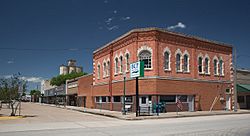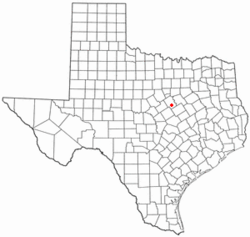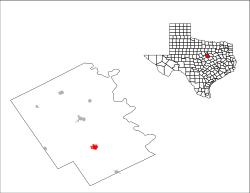Clifton, Texas facts for kids
Quick facts for kids
Clifton, Texas
|
|
|---|---|

Downtown Clifton
|
|
| Nickname(s):
Norwegian Capital of Texas
|
|

Location of Clifton, Texas
|
|
 |
|
| Country | United States |
| State | Texas |
| County | Bosque |
| Area | |
| • Total | 2.06 sq mi (5.34 km2) |
| • Land | 2.05 sq mi (5.31 km2) |
| • Water | 0.01 sq mi (0.03 km2) |
| Elevation | 682 ft (208 m) |
| Population
(2020)
|
|
| • Total | 3,465 |
| • Density | 1,682/sq mi (648.9/km2) |
| Time zone | UTC-6 (Central (CST)) |
| • Summer (DST) | UTC-5 (CDT) |
| ZIP codes |
76634, 76644
|
| Area code(s) | 254 |
| FIPS code | 48-15472 |
| GNIS feature ID | 2409484 |
Clifton is a city in Bosque County, Texas, United States. It is the largest city in the county. In 2020, about 3,465 people lived there.
Norwegian settlers first came to Clifton and the nearby areas in the mid-1800s. Today, this part of Texas is known as the Norse Historic District. It is even listed on the National Register of Historic Places.
Contents
Clifton's Early History
Clifton was started in the winter of 1852–1853. Families like the Kells and Lockers moved to the area. The town was first called Cliff Town because of the limestone cliffs nearby. Over time, the name changed to Clifton.
The first public buildings were a Masonic lodge hall and a log schoolhouse. A post office opened in 1859. The First Presbyterian Church of Clifton began in 1861. It is the oldest church in the county that has been open continuously.
Growth and Development
After the Civil War, a man named Joel Martin Stinnett built a flour mill. It was powered by the Bosque River. Later, this mill became an electric power plant. It brought the first electricity to homes and businesses in Clifton.
Around 1870, a three-story school called Rock School was built. It served the community for over 20 years. In 1893, a new school building was constructed. The land for it was given to the Clifton school system.
Railroad and Business Boom
In 1880, the Gulf, Colorado and Santa Fe Railway built a station near Clifton. Many businesses moved closer to the railroad. This helped the town grow as a center for trade.
The Clifton Record, a local newspaper, started in 1895. Clifton was even the county seat for a short time, from 1890 to 1892. Clifton Lutheran College, later called Clifton College, opened in 1896. The town officially became a city in 1901.
Challenges and Community Spirit
A big fire in 1906 destroyed much of the business area. But the town quickly rebuilt. The Clifton Volunteer Fire Department was formed in 1907.
In 1938, two doctors opened the Goodall-Witcher Hospital. It is still helping people today. The Lutheran Sunset Home for the elderly opened in 1954. In 1991, the Bosque River flooded parts of the town after heavy rains.
Weather Events
Clifton has seen some interesting weather. On December 21, 1929, a weather station near Clifton recorded 24 inches of snow. This is the most snow ever recorded in Texas in one day.
On January 15, 2017, an EF1 Tornado hit Clifton. It damaged at least 25 homes. Luckily, no one was hurt.
Clifton's Location and Weather
Clifton is located in Texas. The city covers about 1.9 square miles (5.34 square kilometers) of land.
Climate in Clifton
Clifton has a humid subtropical climate. This means it has hot, humid summers. The winters are usually mild to cool.
People of Clifton
Clifton has grown over the years. Here's how its population has changed:
|
||||||||||||||||||||||||||||||||||||||||||||||||||||||||||||||||||||
Clifton's Population in 2020
In 2020, there were 3,465 people living in Clifton. There were 1,358 households and 925 families.
| Race | Number | Percentage |
|---|---|---|
| White (NH) | 2,139 | 61.73% |
| Black or African American (NH) | 84 | 2.42% |
| Native American or Alaska Native (NH) | 8 | 0.23% |
| Asian (NH) | 27 | 0.78% |
| Some Other Race (NH) | 4 | 0.12% |
| Mixed/Multi-Racial (NH) | 167 | 4.82% |
| Hispanic or Latino | 1,036 | 29.9% |
| Total | 3,465 |
Clifton's Norwegian Culture
In 1997, the Texas Legislature officially named Clifton the "Norwegian Capital of Texas." This is because many Norwegian immigrants settled here in the mid-1800s.
The nearby town of Norse is where Cleng Peerson is buried. He is known as the "Father of Norwegian Immigration to America."
Exploring Norwegian Heritage
Visitors can learn about Norwegian pioneers at the Bosque Memorial Museum. You can also drive on the Cleng Peerson Memorial Highway to the Norse Historic District. Along this road, you'll see many old homes and churches from the 1800s.
One important church is Our Savior's Lutheran Church, built in 1869. This church hosts the annual Norse Smorgasbord. This is a feast of traditional Norwegian foods. Another event is the annual Lutefisk dinner in Cranfills Gap, near the historic St. Olaf Kirke, also called the Old Rock Church.
Norwegian Country Christmas Tour
Clifton celebrates its Norwegian roots every year with the Norwegian Country Christmas Tour. It happens on the first Saturday of December. This event shows off Norwegian crafts and offers tours of old homes. It's a fun way to experience the town's history.
Arts and Education in Clifton
Clifton is a special place for arts. In 2011, it was named a Cultural District by the State of Texas.
Bosque Arts Center
The Bosque Arts Center is in a restored building that used to be part of Clifton College. It offers many art programs for a city of Clifton's size. You can find a theater, art classes, and an annual photography show here. There's also a nationally recognized art show called the Conservatory Art Classic.
Clifton has been named one of the top 100 small art communities in the nation more than once. It is home to famous artists, including some from the Cowboy Artists of America. Artist Merritt Mauzey was the first Texan to receive a Guggenheim Foundation fellowship in fine arts in 1946.
Schools in Clifton
The Clifton Independent School District serves the city.
- Clifton High School (Grades 9–12)
- Clifton Middle School (Grades 6–8)
- Clifton Intermediate School (Grades 3–5)
- Clifton Elementary School (Grades PreK–2)
Local News and Media
Clifton and Bosque County are part of the Dallas-Fort Worth media market. However, stations from the Waco/Temple–Killeen area also provide news coverage.
The Clifton Record is the local newspaper for the community.
Famous People from Clifton
Many notable people have come from Clifton:
- Dan Campbell, an NFL head coach for the Detroit Lions
- Bobby Joe Conrad, a former NFL wide receiver
- Zach Duke, an MLB pitcher
- Bernie Erickson, a former NFL linebacker
- Jessie James Grelle, an anime voice actor
- Merritt Mauzey, a printmaker and children's book author
- C.E. "Pat" Olsen, who founded Gearench Mfg Co.
Images for kids
See also
 In Spanish: Clifton (Texas) para niños
In Spanish: Clifton (Texas) para niños









